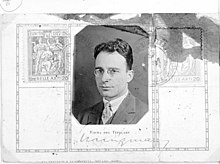Kurt Seligmann
Kurt Seligmann | |
|---|---|
 Kurt Seligmann, pictured in an Italian museum passport, 1927 | |
| Born | 1900 Basel, Switzerland |
| Died | 1962 |
| Nationality | Swiss |
| Education | Ecole des Beaux Arts |
| Known for | Fantastic imagery of medieval troubadors and knights engaged in macabre rituals |
| Movement | Surrealism |
| Spouse(s) | Arlette Paraf |
This article may be in need of reorganization to comply with Wikipedia's layout guidelines. (April 2017) |
Kurt Leopold Seligmann (1900–1962) was a Swiss-American Surrealist painter and engraver. He was known for his fantastic imagery of medieval troubadors and knights in macabre rituals and inspired by the carnival held annually in his native Basel, Switzerland.
Life and career[]
Born in Basel in 1900, the son of a furniture department store owner, his parents were not in favor of Seligmann's artistic aspirations but eventually relented. After studying at the Ecole des Beaux Arts in Geneva and spending several years working in his father's business in Basel, Seligmann left for Paris where he met with his friends from Geneva, sculptor Alberto Giacometti and art critic Pierre Courthion. During this time, he also met .[1] Through Giacometti he met Hans Arp and Jean Hélion, who admired his sinister bio-morphic paintings and invited him to join their group, Abstraction-Creation Art Non-Figuratif.
In the mid-1930s his work began to take on a more baroque aspect, as he animated the prancing figures in his paintings and etchings with festoons of ribbons, drapery, and heraldic paraphernalia. Around 1935, Seligmann met and married Arlette Paraf, granddaughter of the founder of the . Together they traveled extensively, first around the world during a year-long honey-moon trip in 1936 and then to North America and British Columbia in 1938, to explore American ethnographic art. In 1937, Seligmann was accepted as a member of the Surrealist group in Paris by André Breton, who collected his work and included him in Surrealist exhibitions.
At the outbreak of World War II in September 1939, Seligmann arrived in New York for an exhibition of his work at the Karl Nierendorf Gallery. Once there, however, with Surrealist artists being targeted by Nazis, he began to aid those in France and bring them to safety. The correspondence he maintained during this period is preserved in a collection at the Beinicke Rare Book Library at Yale University.
Seligmann's art continued to evolve and reached maturity during the 1940s in the United States. Beginning in 1940, he and Arlette lived at the Beaux Arts Building at Fortieth Street in Manhattan, and later they acquired a farm north of the city in the hamlet of Sugar Loaf, New York (in Orange County). Seligmann befriended many American artists as well as the art historian, Meyer Schapiro. With Schapiro as author, in 1944 he produced a limited edition set of six etchings illustrating the Myth of Oedipus. In 1948, a book called The History of Magic was published under his name by Pantheon Books. After the war, his work began to be exhibited widely and acquired by museums throughout the United States and Europe.
Seligmann taught at various colleges in New York City, particularly at Brooklyn College, from which he retired in 1958. The changing nature of the New York art world, as it embraced Abstract Expressionism, caused his work to be relegated to art history and perceived as passé. Due to illness, he gave up his Manhattan apartment and retired to his farm, where he died of an accidentally self-inflicted gunshot wound in January 1962.
Shortly before his death in 1962, his widow, Arlette Seligmann, bequeathed the entire Seligmann estate to the Orange Country Citizens Foundation, a private nonprofit corporation dedicated to the preservation of Orange County, New York. The foundation now serves as Seligmann's official estate and uses the Seligmann's 55-acre (220,000 m2) farm as their office.[2] The U.S. copyright representative for the Orange County Citizen's Foundation and the estate of Kurt Seligmann is the Artists Rights Society.[3] At the request of the Orange County Citizens Foundation, artist, Jonathan Talbot, undertook the restoration of the etching press formerly owned by Kurt Seligmann, which is located on the Seligmann property in Sugar Loaf. The project is expected to be completed by August 2011.
References[]
- ^ Information about Ivy Langton
- ^ "Orange Country Citizens Foundation website: About Us page". Archived from the original on 2009-01-25. Retrieved 2008-07-18.
- ^ Most frequently requested artists list of the Artists Rights Society Archived January 31, 2009, at the Wayback Machine
- Miller, Stephen Robeson, https://web.archive.org/web/20070421140209/http://www.occf-ny.org/seligmann.htm, Boston, Ma. 1995
- Sawin, Martica, Surrealism in exile and the Beginning of the New York School, Massachusetts Institute of Technology, 1995
- Seligmann, Kurt, The History of Magic, Pantheon Books, 1948
External links[]
- Kurt Seligmann Papers. Yale Collection of American Literature, Beinecke Rare Book and Manuscript Library.
- 1900 births
- 1962 deaths
- 20th-century Swiss painters
- 20th-century male artists
- Swiss male painters
- Ballet designers
- Brooklyn College faculty